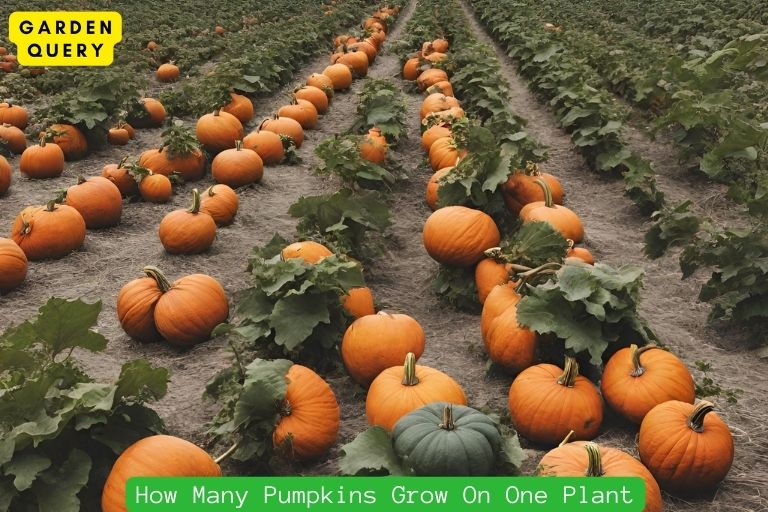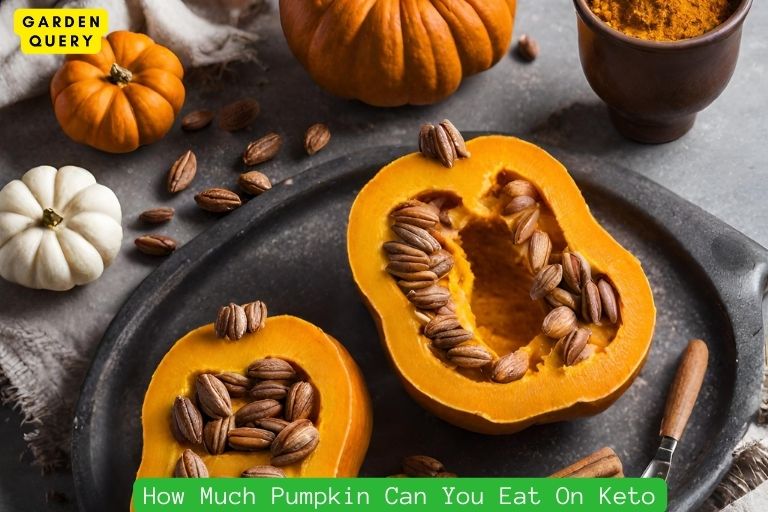How Many Pumpkins Grow On One Plant?
How Many Pumpkins Grow On One Plant
What is a pumpkin plant?
A pumpkin plant, scientifically known as Cucurbita, is a type of vine that belongs to the gourd family. It is widely cultivated for its large, orange fruits that are commonly used for carving during Halloween, cooking, and decoration purposes.

Factors affecting pumpkin plant growth
To determine how many pumpkins can grow on one plant, several factors come into play:
- Variety: Different pumpkin varieties produce varying numbers of pumpkins. Some varieties may yield only a few pumpkins, while others may have the potential to produce a multitude.
- Pollination: Pumpkins require proper pollination to produce fruits. Bees and other insects play a crucial role in the pollination process by transferring pollen from the male flower to the female flower. Without sufficient pollination, the plant may not produce as many fruits.
- Plant health: Healthy pumpkin plants are more likely to produce a greater number of pumpkins. Adequate nutrition, sufficient water, and protection from pests and diseases are essential for promoting plant health and maximizing fruit production.
- Growing conditions: The growing conditions, such as sunlight, temperature, and soil quality, can significantly influence the productivity of pumpkin plants. Optimal growing conditions provide the ideal environment for the plant to thrive and produce more pumpkins.
It’s important to note that while each pumpkin plant has the potential to produce multiple fruits, the actual number can vary. Factors such as plant maturity, growing techniques, and environmental factors can impact the final yield. Additionally, proper care and maintenance, such as pruning and fertilizing, can also enhance pumpkin plant growth and productivity.
In conclusion, the number of pumpkins that can grow on one plant is influenced by various factors, including the plant variety, pollination, plant health, and growing conditions. By providing the optimal conditions and taking proper care of the plants, you can increase the chances of obtaining a bountiful pumpkin harvest.
Pumpkin Plant Varieties
If you’ve ever wondered how many pumpkins can grow on one plant, you’re not alone. The answer to that question depends on the type of pumpkin plant you have. There are several different varieties of pumpkin plants, each with its own characteristics and yield potential.
Types of pumpkin plants and their characteristics
- Jack-o’-lantern Pumpkins: These are the classic, large orange pumpkins that are perfect for carving into scary faces and decorating your front porch. Jack-o’-lantern pumpkins typically produce one to two pumpkins per plant, with an average weight of 10-30 pounds.
- Miniature Pumpkins: These adorable tiny pumpkins are great for fall decorations and can also be used for cooking. Miniature pumpkin plants can produce up to six pumpkins per plant, with an average weight of 1-2 pounds.
- Pie Pumpkins: As the name suggests, these pumpkins are perfect for making delicious pies and other baked goods. Pie pumpkin plants usually produce one to two pumpkins per plant, with an average weight of 5-10 pounds.
- Giant Pumpkins: If you’re looking to grow the biggest pumpkin on the block, then giant pumpkin plants are for you. These plants require a lot of space and care, but they can produce enormous pumpkins that weigh over 100 pounds.
Choosing the right pumpkin plant for your needs
When deciding which pumpkin plant to grow, consider your needs and available resources. If you want a pumpkin for carving or decorative purposes, a jack-o’-lantern or miniature pumpkin plant would be a good choice. If you’re interested in using the pumpkins for cooking, then a pie pumpkin plant is the way to go. And if you’re up for a challenge and want to grow a giant pumpkin, make sure you have enough space and time to dedicate to its care.
In conclusion, the number of pumpkins that can grow on one plant varies depending on the variety. Whether you’re growing pumpkins for carving, cooking, or just for fun, there’s a pumpkin plant out there that’s perfect for your needs. So grab your gardening gloves and get ready to enjoy the bountiful harvest of pumpkins from your own backyard.
Growing Conditions
Growing your own pumpkins can be a fun and rewarding experience. But one question that often comes up is, how many pumpkins can grow on one plant? Let’s explore the key factors that determine pumpkin growth.
Ideal soil and temperature requirements for pumpkin plants
Pumpkins thrive in well-drained soil that is rich in organic matter. The ideal soil pH ranges from 6.0 to 7.5. It’s essential to prepare the soil properly before planting by tilling it and incorporating compost or manure.
When it comes to temperature, pumpkins prefer warm weather. The soil temperature should be around 70°F (21°C) for optimal growth. The air temperature should be consistently above 50°F (10°C) during the day and not drop below 40°F (4°C) at night.
Sunlight and water needs
Sunlight is crucial for pumpkin plants as they require at least six to eight hours of direct sunlight each day. Ensure your pumpkin patch is in a sunny location to maximize plant growth.
Watering is essential to keep pumpkin plants hydrated, especially during hot and dry periods. Ideally, pumpkins need about 1 inch (2.5 cm) of water per week. Be mindful not to overwater, as this can lead to root rot. Water the plants deeply at the soil level rather than using overhead sprinklers to prevent disease and mildew.
It’s worth mentioning that the number of pumpkins that can grow on one plant depends on various factors, including the pumpkin variety, plant health, and pollination success. On average, a healthy pumpkin plant can produce one to three pumpkins. However, some varieties are known for producing more. For example, small Jack-o’-lantern types may yield around six to eight pumpkins per plant.
In conclusion, providing the right growing conditions including soil quality, optimal temperature, sunlight, and proper watering practices will optimize pumpkin plant health and increase the chances of a successful harvest. So get out there and enjoy the process of watching those pumpkins grow!
Pumpkin Plant Growth Stages
Seed planting and germination
Planting pumpkin seeds is a simple process that can be done either directly in the ground or in pots. Before planting, ensure the soil is rich in organic matter and has good drainage. Place the seeds about an inch deep into the soil and keep them moist.
Germination typically takes 5 to 10 days, depending on the variety and the growing conditions. During this stage, it’s important to provide the seeds with adequate sunlight and water. As the seedlings start to emerge, thin them out to allow proper spacing between plants.
Vine growth and pumpkin formation
Once the seedlings have grown a few inches tall, they will start developing vine growth. Pumpkin plants prefer warm temperatures and require plenty of sunlight, so make sure they are planted in an area that receives at least six hours of direct sunlight each day.
As the plants continue to grow, they will start flowering. Female flowers have a small pumpkin-shaped structure at the base, while male flowers have a straight stem. Bees play a crucial role in pollination, transferring pollen from the male flowers to the female flowers.
After successful pollination, the flowers will wither away, and the fruits start forming. Each pumpkin plant usually produces multiple pumpkins, ranging from two to six, depending on the variety. The size and number of pumpkins also depend on the care provided, including proper watering, fertilizing, and pruning.
It is important to note that not all pumpkins from a single plant will reach full maturity. Some may not develop fully or may rot prematurely. Regular inspection and care will help identify and address any issues that may arise.
In conclusion, pumpkin plants go through two main growth stages, starting with seed planting and germination, followed by vine growth and pumpkin formation. By providing the right conditions and care throughout these stages, you can maximize the number and size of pumpkins harvested from a single plant. Remember to enjoy the journey, from planting the seeds to the time you harvest those vibrant orange pumpkins for your fall decorations or delicious recipes.
Harvesting Pumpkins
As the autumn season approaches, many people look forward to enjoying pumpkin pies, decorating their homes with carved pumpkin lanterns, or even participating in pumpkin smashing contests. But have you ever wondered how many pumpkins can grow on one plant? Let’s dive into this fascinating question!
Determining the right time to harvest
Determining the right time to harvest your pumpkins can be crucial for optimal growth and flavor. Here are some signs to look out for:
- Ripe color: Pumpkins usually reach their full color potential when they are ready to be harvested. For example, orange varieties will turn a deep, rich orange color.
- Firmness: Check the firmness of the pumpkin by gently pressing your finger against the skin. A ripe pumpkin should have a hard exterior.
- Drying vines: As pumpkins mature, the vines they grow on begin to dry out and wither. This is a good indication that it’s time to harvest.
Tips for harvesting and storing pumpkins
Once you’ve determined that your pumpkins are ready for harvesting, follow these tips to ensure they stay fresh and delicious:
- Cut: Use a sharp knife or a pair of pruning shears to cut the pumpkin from the vine, leaving a few inches of stem attached. Avoid pulling or twisting the pumpkin, as this may damage the plant or the fruit.
- Clean: Remove any dirt or debris from the surface of the pumpkin using a soft cloth or brush. Be gentle to avoid causing any damage.
- Cure: Allow freshly harvested pumpkins to cure in a warm, well-ventilated area for about two weeks. This process helps toughen the skin and reduces the risk of rotting.
- Storage: Store cured pumpkins in a cool, dry place such as a basement, garage, or cellar. They can last for several months if stored properly.
Remember, the number of pumpkins that grow on one plant can vary depending on factors such as the variety, growing conditions, and care. However, with the right knowledge and attention, you can enjoy a bountiful harvest of pumpkins that you can use for various fall activities and culinary endeavors.
Now, it’s time to grab your carving tools and get creative with those freshly harvested pumpkins!
Maximizing Pumpkin Yield
When it comes to pumpkin plants, gardeners often wonder how many pumpkins can grow on a single plant. The answer varies depending on various factors, but by employing some key techniques, you can maximize your pumpkin yield.
Pruning and training techniques
Pruning and training are essential practices that can help increase the number of pumpkins on a plant. By removing excess foliage and selectively pruning branches, you allow the plant to focus its energy on producing more pumpkins. Training the vines by gently guiding them towards open spaces can also provide better air circulation and enable more pumpkin development. These practices not only enhance the plant’s aesthetics but also its productivity.
Fertilization and pest control
Proper fertilization and pest control are crucial for maximizing pumpkin yield. Pumpkin plants thrive in nutrient-rich soil, so regular fertilization is key. Apply a balanced fertilizer with higher phosphorus content when the plant starts producing female flowers. Adequate watering is also essential for optimum nutrient absorption and pumpkin growth.
To prevent pests and diseases from affecting your pumpkins, implement effective pest control measures. This can include using organic insecticides or repellents, practicing crop rotation, and removing any diseased or infested plant parts promptly. Regularly inspect your plants for signs of pests or diseases and take immediate action to protect your pumpkin crop.
By implementing these techniques and providing the right growing conditions, you can encourage your pumpkin plants to produce a satisfying number of pumpkins. Remember to choose a cultivar suited for your growing region and climate, as different pumpkin varieties have varying growth habits and yield potentials.
So, don’t hesitate to get your hands dirty and start maximizing your pumpkin yield. With a little effort and proper care, you’ll be amazed at how many pumpkins can grow on a single plant.
Common Challenges and Solutions
Common problems faced while growing pumpkins
Growing pumpkins can be a rewarding experience, but it does come with its fair share of challenges. Here are some common problems that gardeners often face:
- Pest infestations: Pumpkins are susceptible to various pests, including squash bugs, aphids, and vine borers. These pests can damage the plant and reduce the yield.
- Diseases: Powdery mildew, downy mildew, and black rot are some diseases that can affect pumpkin plants. These diseases can cause wilting, discoloration, and rotting of the fruits.
- Weed competition: Weeds can compete with pumpkin plants for nutrients, water, and sunlight, hampering their growth and productivity.
Tips for preventing and managing issues
Fortunately, there are several measures gardeners can take to prevent and manage these challenges:
- Pest control: Monitor your plants regularly for signs of pest infestations. Consider using organic insecticides, such as neem oil, to control pests. Introducing beneficial insects like ladybugs can also help keep pest populations in check.
- Disease prevention: Choose disease-resistant pumpkin varieties when possible. Provide adequate spacing between plants to improve air circulation and reduce the chances of disease spread. Avoid overhead watering, as it can promote the growth of fungal pathogens. Apply fungicides if necessary.
- Weed management: Mulch around pumpkin plants to suppress weed growth. Hand-pull weeds when they are small, taking care not to disturb the pumpkin plant’s roots. Consider using a pre-emergent herbicide before planting to prevent weed seeds from germinating.
By being proactive and implementing these solutions, gardeners can increase their chances of a successful pumpkin harvest. Remember to maintain proper watering, fertilization, and sun exposure to promote healthy growth and optimize production.
In conclusion, while growing pumpkins may present some challenges, with the right strategies and care, it is possible to overcome them and enjoy a bountiful harvest of beautiful and delicious pumpkins. So roll up your sleeves, get out in the garden, and start growing those pumpkins!
- Best Therapists In Dallas - February 1, 2024
- Holly Willoughby Husband: Holly Willoughby’s Love Story - January 30, 2024
- Holly Willoughby Dress: 5 Style Secrets and 7 Must-Know Career Milestones - January 30, 2024





